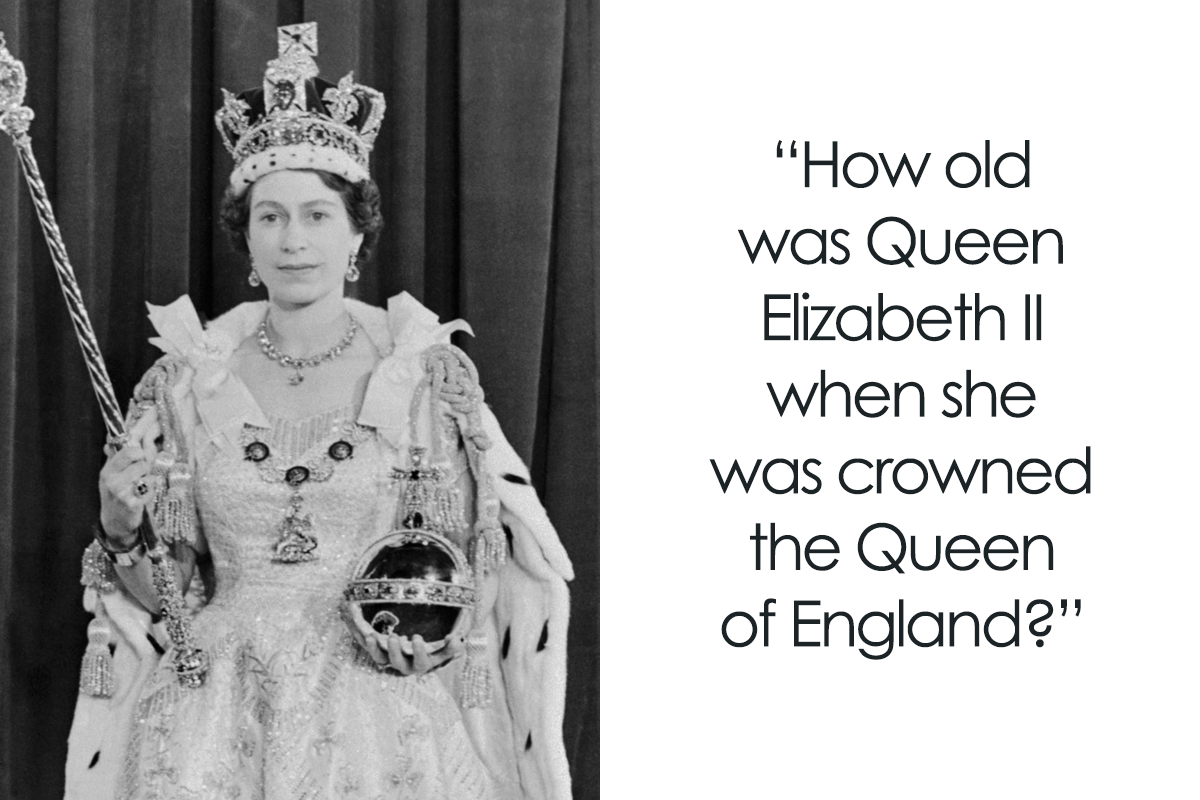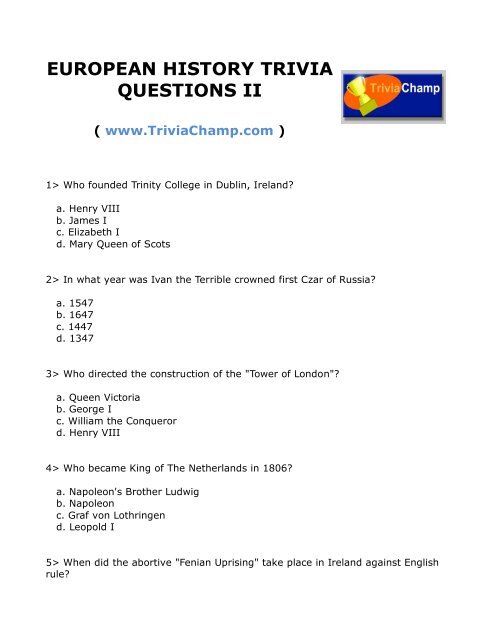### History Trivia Answer The Battle of Hastings took place in 1066. William the Conqueror emerged victorious over King Harold II.
### Introduction The Battle of Hastings is a pivotal moment in English history. Taking place on October 14, 1066, this battle dramatically changed the course of the nation. William the Conqueror, Duke of Normandy, defeated the Anglo-Saxon King Harold II. This victory marked the beginning of Norman rule in England.
The battle’s outcome significantly influenced the cultural, political, and social landscape. Norman customs, language, and governance began to permeate English society. Understanding this event provides insight into how modern England was shaped. The Battle of Hastings remains a key historical event taught in schools and explored by historians worldwide. It underscores the importance of military strategy and leadership in altering a nation’s destiny.
Diving Into Historical Curiosities
History is full of fascinating stories. Uncovering these stories can be thrilling. History trivia questions help us dive into these amazing tales. They spark curiosity and make learning fun.
Why Trivia Spurs Interest In History
Trivia questions can be very engaging. They make learning history enjoyable. A simple question can lead to a deeper exploration.
For example, Did you know Julius Caesar was kidnapped by pirates? This fun fact makes you want to learn more about him. Such questions grab attention and stir curiosity.
- They make history interactive.
- They make facts memorable.
- They turn learning into a game.
The Role Of Trivia In Education
Trivia plays a crucial role in education. It helps students remember facts better. Here are some reasons why:
| Benefits | Description |
|---|---|
| Engagement | Trivia keeps students engaged. They enjoy answering questions. |
| Memory Retention | Repetition of trivia questions helps with memory retention. |
| Critical Thinking | Trivia encourages critical thinking. It makes students think deeper. |
Teachers can use trivia to make lessons more interesting. This makes learning history a fun experience.
Ancient Civilizations’ Secrets
Ancient civilizations hold many secrets. Their stories are fascinating and mysterious. Unraveling these secrets is like a treasure hunt. Let’s dive into some intriguing trivia questions about these ancient worlds.
Mysteries Of Egypt
Egypt is known for its grand pyramids and the Sphinx. These structures are over 4,000 years old. The Great Pyramid of Giza is the most famous. It’s one of the Seven Wonders of the Ancient World.
Egyptians were master builders and mathematicians. They used simple tools to create precise structures. Some questions about Egypt include:
- Who was the first female pharaoh?
- What is the Book of the Dead?
- How were the pyramids built?
Answers to these questions reveal much about Egyptian society. They show their beliefs, skills, and daily life.
Intrigues Of The Roman Empire
The Roman Empire was vast and powerful. It covered most of Europe and parts of Africa and Asia. Rome was known for its military strength and advanced engineering.
Romans built roads, aqueducts, and impressive buildings. They also had a complex system of laws. Some interesting questions about Rome are:
- Who was the first emperor of Rome?
- What was the significance of the Roman Forum?
- How did Romans entertain themselves?
These questions help us understand the Roman way of life. They show us how Romans influenced the modern world.
Medieval Enigmas And Legends
The medieval era is filled with mystery and excitement. Dive into the past with these history trivia questions. Discover the world of knights, castles, and mythical tales.
Knights, Castles, And Quests
Knights wore shining armor and protected their lands. They trained hard and followed a code of honor. Castles were huge stone buildings where kings and queens lived. They had thick walls and tall towers.
Quests were adventurous journeys. Knights often went on quests to prove their bravery. They faced many dangers and solved riddles along the way.
- Who was the most famous knight of the Round Table? – Sir Lancelot
- What was the purpose of a moat around a castle? – To protect from invaders
- Which legendary quest involved the Holy Grail? – The quest for the Holy Grail
Mythical Tales And Historical Facts
Mythical tales mixed with real events create rich stories. Dragons, wizards, and magical swords fill these legends. Some stories are based on real people and events.
King Arthur is a well-known legend. He had a magical sword named Excalibur. He formed the Round Table with his knights. Many think King Arthur was based on a real person.
- Who was Merlin? – A wise and powerful wizard
- What was the name of King Arthur’s sword? – Excalibur
- Was King Arthur a real person? – Historians still debate this
| Myth | Fact |
|---|---|
| Dragons lived in medieval times. | No evidence of real dragons. |
| Knights always wore heavy armor. | Only for battles. |
| All castles had moats. | Not all did. |

Credit: www.etsy.com
The Renaissance And Human Progress
The Renaissance was a time of amazing change. People made great art and new scientific discoveries. This period helped human progress in many ways.
Artistic Marvels
During the Renaissance, artists created stunning works. Leonardo da Vinci painted the famous “Mona Lisa.” Michelangelo sculpted the incredible “David.” Their works still inspire people today.
Artists used new techniques. They made paintings look more real. Perspective was a new method that showed depth. This made their art look three-dimensional.
Scientific Breakthroughs
Many scientific discoveries happened during the Renaissance. Galileo Galilei studied the stars. He improved the telescope. His findings changed our view of the universe.
Nicolaus Copernicus had a big idea. He said the Earth moves around the Sun. This was very different from what people believed before.
| Artist | Work |
|---|---|
| Leonardo da Vinci | Mona Lisa |
| Michelangelo | David |
- Leonardo da Vinci – Painter of the Mona Lisa.
- Michelangelo – Sculptor of David.
- Galileo Galilei – Improved the telescope.
- Nicolaus Copernicus – Earth moves around the Sun.
- The Renaissance was a time of change.
- Artists used new techniques like perspective.
- Galileo studied the stars with a better telescope.
- Copernicus said the Earth moves around the Sun.
Revolutionary Minds Changing The World
Revolutionary minds have always changed the world with their ideas. These thinkers and inventors reshaped history and society. Let’s delve into some of these incredible figures and their groundbreaking inventions.
Figures Behind Major Revolutions
Many people led major revolutions. Their actions and ideas transformed societies. Here are some key figures:
- George Washington: Leader of the American Revolution.
- Napoleon Bonaparte: Influenced the French Revolution and reshaped Europe.
- Mahatma Gandhi: Led India’s non-violent independence movement.
These leaders shaped the destinies of their nations. Their influence extended beyond borders, changing global history.
Inventions That Shaped Modern Society
Inventions have also played a pivotal role in shaping modern society. Let’s look at some groundbreaking inventions:
| Invention | Inventor | Impact |
|---|---|---|
| Light Bulb | Thomas Edison | Revolutionized indoor lighting. |
| Telephone | Alexander Graham Bell | Changed global communication. |
| Internet | Tim Berners-Lee | Connected the world digitally. |
Each of these inventions has had a lasting impact on our daily lives. They simplified tasks, connected people, and advanced technology.
Wars And Their Hidden Stories
Wars shape nations and change lives. Yet, many stories remain untold. These hidden tales reveal strategies, bravery, and unexpected outcomes. Let’s explore some fascinating aspects of wars that history often overlooks.
Untold Tales From World Wars
The World Wars were massive conflicts with countless untold stories. One such story is about animals in war. Did you know that pigeons played a key role in World War I? They carried messages across enemy lines, saving many lives.
Another lesser-known tale is the Christmas Truce of 1914. Soldiers from both sides stopped fighting and celebrated together. They exchanged gifts, sang carols, and played football. This event showed the humanity amidst the horror of war.
| Event | Description |
|---|---|
| Pigeons in WWI | Pigeons delivered messages, saving lives. |
| Christmas Truce 1914 | Soldiers celebrated Christmas together, showing humanity. |
Strategies That Altered History
Some strategies in war changed history forever. During World War II, the Enigma code was a major German encryption tool. Breaking this code was crucial for the Allies. The brilliant mathematician Alan Turing led this effort. His work shortened the war and saved countless lives.
Another key strategy was the D-Day invasion. The Allies planned a surprise attack on Normandy beaches. This operation involved deception tactics to mislead the Germans. The successful invasion marked a turning point in the war.
- Enigma Code: Cracked by Alan Turing, it shortened the war.
- D-Day Invasion: Deception tactics led to a successful surprise attack.
Cultural Riddles Across Continents
Every continent holds its own secrets and riddles. These puzzles often stem from deep-rooted traditions and cultural practices. Let’s explore some fascinating riddles and their origins.
Traditions With Mysterious Origins
Many traditions have origins that remain a mystery. Here are some intriguing examples:
- Stonehenge: A prehistoric monument with unknown purpose.
- Egyptian Pyramids: How were these massive structures built?
- Japanese Tea Ceremony: Its exact beginnings are shrouded in mystery.
These traditions showcase the rich history and culture of their regions. They also raise questions that continue to baffle historians.
Cultural Practices Lost To Time
Some cultural practices have been lost over time. Below are a few examples:
| Practice | Region | Description |
|---|---|---|
| Oracle Bones | China | Used for divination in ancient times. |
| Runic Inscriptions | Scandinavia | Symbols used by Norsemen, purpose still debated. |
| Inca Quipu | South America | Knotted strings used for record-keeping. |
These practices give us a glimpse into the past. They highlight the creativity and ingenuity of ancient civilizations.

Credit: www.boredpanda.com

Credit: www.yumpu.com
Frequently Asked Questions
What Is The Oldest Known Civilization?
The Sumerian civilization in Mesopotamia is the oldest known, dating back to around 4500 BCE.
Who Built The Great Wall Of China?
The Great Wall was built by several Chinese dynasties, primarily the Qin Dynasty around 221 BCE.
When Did The Roman Empire Fall?
The Western Roman Empire fell in 476 AD, marking the end of ancient Rome.
Who Was The First Emperor Of Japan?
Emperor Jimmu, who ascended the throne in 660 BCE, is considered the first emperor of Japan.
Where Was The Battle Of Hastings Fought?
The Battle of Hastings was fought in 1066 near Hastings, England.
Conclusion
Exploring history through trivia questions brings joy and knowledge. Engaging with history trivia sharpens your mind and broadens your perspective. Challenge yourself regularly to keep learning. Share your newfound facts with friends and family. Embrace the fun and excitement that history trivia offers.
Dive into the past and enjoy the journey!